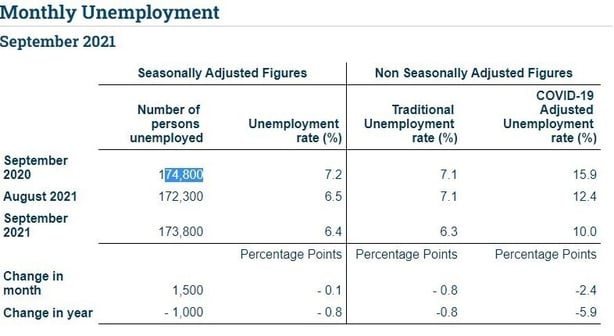The country's unemployment rate, including people receiving temporary Covid-19 jobless benefits, fell to a new pandemic low of 10% in September from 12.4% in August, new figures from the Central Statistics Office show today.
The unemployment rate - including those getting the Pandemic Unemployment Payment - had stood at 15.9% in September of last year.
The CSO said that excluding recipients of the PUP, which is being gradually phased out over the next five months, the jobless rate fell to 6.4% from a revised 6.5%.
Today's figures show that the seasonally adjusted number of people who were unemployed stood at 173,800 in September of this year, down from 174,800 the same time last year.
The Finance Department forecast last week that unemployment would average 7.2% next year and fall to 6% in 2023 as the economy continues to recover from Covid-19.
Today's CSO figures show that the unemployment rate in September was 6.6% for men and 6.3% for women.
Breaking down the figures by age, the unemployment rate was 17.4% for people from the age of 15 to 24 years and 4.7% for people aged from 25 to 74 years.

Commenting on today's CSO figures, Jack Kennedy, economist at global job site Indeed, said the continued downward trend in unemployment is further proof that economic momentum is building following the easing of lockdown measures.
Jack Kennedy said the positive trend is consistent with the optimistic employment outlook today from the Central Bank, which is forecasting that the unemployment rate will reduce to 5.9% by 2023.
Mr Kennedy noted that as the reductions in PUP came closer, people on payments became much more active in their job searching.
A recent Indeed survey showed that 36% of those on PUP were urgently seeking a new role in August, rising from 13% in July.
"This cohort should find plenty of opportunities given the strong demand from employers for staff, with the level of job postings on Indeed Ireland 37% ahead of their pre-pandemic baseline. Sectors like tourism and hospitality are amongst those facing acute staff shortages," the economist said.
"Our research also suggests that over a quarter of job seekers are still waiting for more job opportunities before taking the plunge, indicating a potential disconnect between the roles employers want to fill and the types of jobs that are viewed as desirable," he added.

